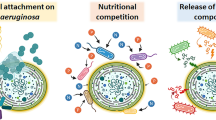Abstract
Sensitivity of tropical freshwater microalgae (Mesotaenium sp., Chlorococcum sp. and Scenedesmus sp.) to environmentally relevant concentrations of hexavalent chromium (Cr6+) and cadmium (Cd2+) was compared individually in three growth media viz. Bold’s Basal Medium (BBM), Test Medium 1 (TM1) and Test Medium 2 (TM2) based on fluorescence reduction. Free metal content of growth media was determined by Visual MINTEQ (version 3.1). After 24 h, relative fluorescence of microalgae in the three media decreased with increased metal concentration showing a concentration dependent graded toxicity response. All microalgae were more sensitive to the metals when grown in TM1, when compared, more sensitive to Cr6+ than Cd2+. Metal speciation indicated that TM1 and TM2 media have higher percentage of bioavailable Cd2+ than BBM, and chromium was present mainly as CrO42− and HCrO4−. The results suggest that the TM1 medium is more suitable under short term exposure of microalgae to metals in environmental monitoring.



Similar content being viewed by others
References
Adriano DC (2001) Cadmium. Trace elements in the terrestrial environments. Springer, New York, pp 263–314
APHA (1999) Standard methods for the examination of water and wastewater, 20th edn. American Public Health Association. http://www.mwa.co.th/download/file_upload/SMWW_1000-3000.pdf. Accessed 20 Jan 2016
Bellinger EG (1992) A key to common algae, 4th edn. The Institution of Water and Environmental Management, London
Bold HC, Wynne MJ (1978) Introduction to the algae: structure and reproduction. Prentice-Hall, Upper Saddle River
Brayner R, Couté A, Livage J, Perrette C, Sicard C (2011) Micro-algal biosensors. Anal Bioanal Chem 401:581–597
Cervantes C, Campos-Garcia J, Devars S, Gutierrez-Corona F, Loza-Tavera H, Torres-Guzman JC, Moreno-Sanchez R (2001) Interactions of chromium with microorganisms and plants. FEMS Microbiol Rev 25:335–347
da Costa CH, Perreault F, Oukarroum A, Melegari SP, Popovic R, Matias WG (2016) Effect of chromium oxide (III) nanoparticles on the production of reactive oxygen species and photosystem II activity in the green alga Chlamydomonas reinhardtii. Sci Total Environ 565:951–960
Eisentraeger A, Dott W, Klein J, Hahn S (2003) Comparative studies on algal toxicity testing using fluorometric microplate and Erlenmeyer flask growth-inhibition assays. Ecotoxicol Environ Saf 54:346–354
Ferro Y, Perullini M, Jobbagy M, Bilmes SA, Durrieu C (2012) Development of a biosensor for environmental monitoring based on microalgae immobilized in silica hydrogels. Sensors 12:16879–16891
Finney DJ (1971) Probit analysis, 3rd edn. Cambridge University Press, Cambridge
Förstner U, Wittmann GTW (2012) Metal pollution in the aquatic environment. Springer, Berlin
Juarez AB, Barsanti L, Passarelli V, Evangelista V, Vesentini N, Conforti V, Gualtieri P (2008) In vivo microspectroscopy monitoring of chromium effects on the photosynthetic and photoreceptive apparatus of Eudorina unicocca and Chlorella kessleri. J Environ Monit 10(11):1313–1318
Kano N (2018) Carboxymethyl-chitosan cross-linked 3-aminopropyltriethoxysilane membrane for speciation of toxic chromium from water. In: Chitin-chitosan-myriad functionalities in science and technology. IntechOpen, Rijeka
Kituyi L, Amayi J, Onindo C (2017) The speciation of cadmium and zinc from pulp and paper mill effluent with inorganic ligands. In: JKUAT annual scientific conference
Kumar KS, Dahms HU, Lee JS, Kim HC, Lee WC, Shin KH (2014) Algal photosynthetic responses to toxic metals and herbicides assessed by chlorophyll a fluorescence. Ecotoxicol Environ Saf 104:57–71
Li Y, Pei X, Li J, Sun Y, Liang Y, Ao Y (2017) EDTA-assisted phytoremediation of cadmium contaminated soil by Solanum nigrum L. In: 5th International conference on machinery, materials and computing technology (ICMMCT 2017). Atlantis Press, Amsterdam
Liu J, Zhu R, Liang X, Ma L, Lin X, Zhu J, He H, Parker SC, Molinari M (2018) Synergistic adsorption of Cd (II) with sulfate/phosphate on ferrihydrite: An in situ ATR-FTIR/2D-COS study. Chem Geol 477:12–21
Mallick N, Mohn FH (2003) Use of chlorophyll fluorescence in metal-stress research: a case study with the green microalga Scenedesmus. Ecotoxicol Environ Saf 55:64–69
Munagamage T, Rathnayake IVN, Pathiratne A, Megharaj M (2016) Sensitivity of four cyanobacterial isolates from tropical freshwaters to environmentally realistic concentrations of Cr6+, Cd2+ and Zn2+. Bull Environ Contam Toxicol 96:816–821
OECD (2011) OECD guidelines for the testing of chemicals—freshwater alga and cyanobacteria growth inhibition test. OECD/OCDE 201:1–25
Perales-Vela H, Peña-Castro JM, Cañizares-Villanueva RO (2006) Heavy metal detoxification in eukaryotic microalgae. Chemosphere 64:1–10
Pereira M, Bartholomew MC, Sánchez-Fortún S (2013) Biosorption and bioaccumulation of chromium trivalent in Cr(III)-tolerant microalgae: a mechanism for chromium resistance. Chemosphere 93:1057–1063
Peterson HG, Nyholm H, Ruecker N (2005) Algal microplate toxicity test suitable for heavy metals. In: Blaise C, Ferard J (eds) Small scale freshwater toxicity investigations. Springer, Dordrecht, pp 243–270
Piotto FA, Carvalho MEA, Souza LA, Rabêlo FHS, Franco MR, Batagin-Piotto KD, Azevedo RA (2018) Estimating tomato tolerance to heavy metal toxicity: cadmium as study case. Environ Sci Pollut Res 25(27):27535–27544
Shankar AK, Cervantes C, Loza-Tavera H, Avudainayugam S (2005) Chromium toxicity in plants. Environ Int 31(5):739–753
Vignati DAL, Dominik J, Beye ML, Pettine M, Ferrari BJD (2010) Chromium(VI) is more toxic than chromium(III) to freshwater algae: a paradigm to revise? Ecotoxicol Environ Saf 73:743–749
Wang S, Zhang D, Pan X (2013) Effects of cadmium on the activities of photosystems of Chlorella pyrenoidosa and the protective role of cyclic electron flow. Chemosphere 93:230–237
Acknowledgements
Financial support was provided by the National Research Council of Sri Lanka (Research Grant No. 12–092). Metal analysis was conducted using the atomic absorption spectrometer granted by the National Science Foundation of Sri Lanka (Equipment Grant RG/2011/EQ/16).
Author information
Authors and Affiliations
Corresponding author
Electronic supplementary material
Below is the link to the electronic supplementary material.
Rights and permissions
About this article
Cite this article
Munagamage, T., Rathnayake, I.V.N., Pathiratne, A. et al. Comparison of Sensitivity of Tropical Freshwater Microalgae to Environmentally Relevant Concentrations of Cadmium and Hexavalent Chromium in Three Types of Growth Media. Bull Environ Contam Toxicol 105, 397–404 (2020). https://doi.org/10.1007/s00128-020-02950-6
Received:
Accepted:
Published:
Issue Date:
DOI: https://doi.org/10.1007/s00128-020-02950-6




